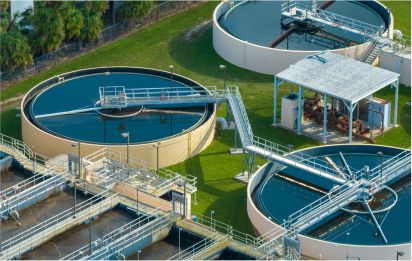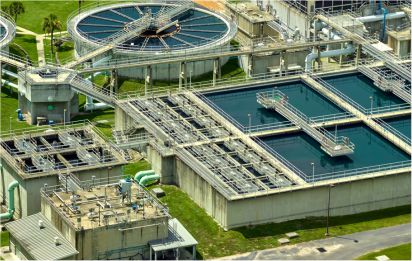SBR is a high-performance solution for wastewater treatment that can
successfully handle batch and continuous flow
operation. It is a proven technology with minimal costs and maintenance
requirements.
SBR Sewage Treatment Process
SBR (Sequencing Batch Reactor) is a widely used method for treating
wastewater, gaining popularity in India, China, and
other Asian countries. It treats sewage in batches through the following
stages:
- • Aeration: Microorganisms break down pollutants, converting ammonia
into less toxic nitrate or nitrite. The treatment
level depends on sludge mass, aeration time, and wastewater strength.
- • Settling: Aeration stops, allowing sludge to settle. Clear effluent
water accumulates above the sludge.
- • Decanting: Effluent water is removed without disturbing the settled
sludge.
- • Idling: The waiting period between filling cycles.
- • Sludge Wasting: Excess sludge is discharged to maintain effluent
quality and microorganism population, regulated by
Mixed Liquor Suspended Solids (MLSS) and Mean Cell Residence Time
(MCRT).
The SBR tank functions as both an aeration tank during reaction and a
secondary clarifier during settling and decanting.
Mixed liquor is allowed to settle, and overflow proceeds to the next
treatment stage. In the sludge return system,
settled influent is mixed with sludge rather than the other way around.
Usage And Application Of SBR-Based Sewage Treatment Plant:
Ideal Applications:
- • Industrial and municipal wastewater, regardless of climate.
- • Personal residences, hotels, resorts, hospitals, and malls.
- • Airports, railway stations, commercial and residential complexes.
- • Schools, colleges, institutions, manufacturing units, and municipal
gardens.
- • Sports complexes and other public places.
Key Features:
- • Handles heavy loads efficiently with a streamlined, cost-optimized
design.
- • Achieves around 98% removal of TSS and BOD; reduces phosphorus and
nitrogen in one step.
- • Highly automated with PLC-based monitoring, requiring minimal human
intervention.
- • Supports continuous feed and true batch operations, resilient to
extraneous water infiltration.
- • Consistently meets effluent discharge limits and adapts to organic and
hydraulic variations.
- • Offers cost-effective upgrades and favorable life cycle costs compared
to other systems.
Advantages:
- • Operator-friendly due to maximum automation.
- • Flexible and resilient, ideal for various applications.
- • Cost-effective initial investment and operational costs.
- • High efficiency and low operator assistance requirements.
Membrane Bioreactor or MBR Sewage Treatment Plant is an innovative wastewater
treatment method. As the name suggests, it
combines two technologies, membrane filtration and the biological treatment.
Membrane Bioreactor (MBR) Wastewater Treatment
Working Principle:
Membrane bioreactor (MBR) technology combines conventional activated sludge
processes with membrane filtration. The
semi-permeable membranes, either microfiltration or ultrafiltration, are
submerged in an aerated biological reactor.
This setup allows high-quality sewage to pass through the membranes,
eliminating the need for sedimentation and
filtration processes. This enhances the efficiency of the biological
treatment.
Process:
- • Pre-treatment: Fine screening to protect the membranes and extend
their lifespan by minimizing solid waste accumulation.
- • Biological Reactor: Wastewater enters the aerated reactor where it
undergoes biological treatment.
- • Membrane Filtration: The treated water is drawn through the membranes,
which remove contaminants and produce
high-quality effluent.
Features:
- • Online backwash system for uninterrupted operation.
- • Produces high-quality treated water.
- • Reduces costs and chemical usage.
- • Eliminates the need for separate settling, clarifying, and polishing
units.
- • Can be installed both underground and above ground.
- • Eco-friendly.
Advantages:
- • High waste removal efficiency.
- • Better effluent quality.
- • Removes bacteria, nitrogen, and suspended solids.
- • Small footprint.
- • Produces less sludge.
Applications:
- • Automobile industries
- • Oil & gas companies
- • Fertilizer & solvent extractors
- • Pharmaceutical industry
- • Pulp & paper industry
MBBR Technology In Wastewater Treatment
Moving Bed Biofilm Reactor (MBBR) technology is a biological wastewater
treatment method, suitable for municipal and
industrial applications, developed in the 1980s. It provides an economical
and efficient solution by using low energy to
treat wastewater, focusing on the separation of organic substances and
processes like nitrification and denitrification.
Key Components and Design
- • Aeration Tank: Similar to an activated sludge tank, it keeps the
sludge and carriers in motion, separating excess
bacteria and sludge directed to a final separator.
- • Plastic Carriers: Made of materials like high-density polyethylene
(HDPE) with a density close to water, they provide a
surface for biofilm growth, ensuring good contact between wastewater and
the biomass.
Benefits
- • Compact and space-saving
- • Easy maintenance
- • Suitable for high load volumes
- • Easy to expand by increasing the carrier filling degree
- • Lower discharge costs and less affected by toxic shock
- • No need for sludge recycling as in activated sludge systems
- • High sludge retention time (SRT), enhancing nitrification
- • Lower sludge production
- • Retrofittable to existing activated sludge tanks for increased
capacity
Applications:
- • BOD Removal: Requires one tank with MBBR and clarification.
- • Nitrification: Uses two tanks—one for BOD removal and another for
nitrification.
- • Denitrification: Involves four aeration tanks for pre-denitrification,
BOD reduction, nitrification, and
post-denitrification, followed by clarification.
Design Considerations:
- • Combines suspended growth (activated sludge) and attached growth
(biofilter) processes
- • Uses the entire tank volume for carriers, enabled by air bubble
agitation
- • Reactors can be of various shapes, fitted with vertical or horizontal
sieves, and are designed based on wastewater
characteristics and locality.
Operation and Maintenance
- • Low-cost operation due to bubble aeration
- • Does not require backwashing or return sludge flows
- • Self-maintaining biofilm levels
- • Maintenance involves screening, sludge handling, influent
equalization, and monitoring pump and blower operations.


